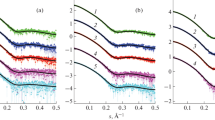Abstract
A combination of small angle X-ray scattering and gel techniques was used to follow the kinetics of protein crystal growth as a function of time. Hen egg white lysozyme, at different protein concentrations, was used as a model system. A new sample holder was designed, in which supersaturation is induced in the presence of salt by decreasing the temperature. It had been shown previously that a decrease in temperature and/or an increase in crystallizing agent induces an increase in the attractive interactions present in the lysozyme solutions, the lysozyme remaining monomeric. In the present paper we show that similar behaviour is observed in NaCl when agarose gels are used. During crystal growth, special attention was paid to determine whether oligomers were formed as the protein in solution was incorporated in the newly formed crystals. From these first series of experiments, we did not find any indication of oligomer formation between monomer in solution and crystal. The results obtained are in agreement with the hypothesis that lysozyme crystals in NaCl grow by addition of monomeric particles.
Similar content being viewed by others
Author information
Authors and Affiliations
Additional information
Received: 28 July 1997 / Revised version: 4 December 1997 / Accepted: 5 December 1997
Rights and permissions
About this article
Cite this article
Finet, S., Bonneté, F., Frouin, J. et al. Lysozyme crystal growth, as observed by small angle X-ray scattering, proceeds without crystallization intermediates. Eur Biophys J 27, 263–271 (1998). https://doi.org/10.1007/s002490050133
Issue Date:
DOI: https://doi.org/10.1007/s002490050133



